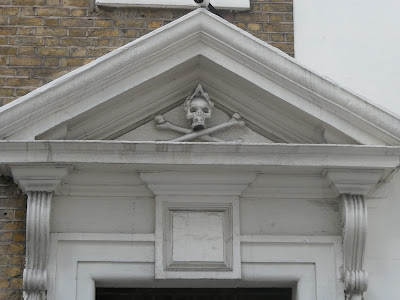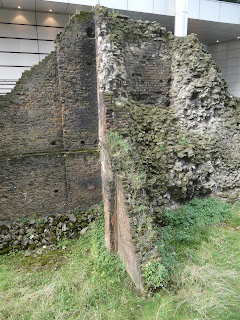An unusually sunny day after a week of deluge, so I decided to go on a walk. This one was in my guidebook described as the "Lost City", basically finding remnants of structures long lost. I omitted some of the best of them as one needs to book, like the Roman baths and the Mithraeum, and the Roman amphitheatre as have done it before more than once.
But, as by definition, this was a walk following things that were now in ruins, it didn't offer the best of photo opportunities, so I leavened it with some shots of more modern London that one can find.
 |
You can tell the Hoop & Grapes pub is properly old from its warped frontage. It is a rare survivor from before the Great Fire, which stopped just before it could consume it in the inferno.
|
Now below is a chunk of Roman Wall contained in the City Wall museum, which itself is in a student block. This chunk of wall survived by being used as a party wall between later buildings. It spent most of the twentieth century sandwiched between an Edwardian office block and a Victorian warehouse. The warehouse came down in the 1970s and the office block was redeveloped, so the wall is now preserved as a feature, looked down upon by a cafe, with archaeological bits and bobs found around it nicely displayed. It is on Vine Street (only really known for its place o the monopoly board) and is free to enter.
 |
| This ancient gravestone is interesting as they don't think it is associated with the wall. Although ancient, they reckon it was brought over by some aristocrat on a Grand Tour in the 18th century and became a garden feature, and became buried that way. |
This is St Olave's Church on Hart Street, and was a diversion from my tour. It is in a suitably obscure spot, one of the smallest churches in the City and another rare survivor from before the Great Fire. Apparently, it was built on the site of the Battle of London Bridge (you didn't know there was a Battle of London Bridge? Not the regular scrum of commuters trying to get on a train, but the battle of 1014 against the Danes )
 |
| Probably the church's main claim to fame is as the last resting place of diarist Samuel Pepys |
Another bit of Roman Wall, this section being outdoors and between Tower Hill station and the Tower of London. The statue in front is not Roman, but of a Roman. Thought to be an 18th century statue of Trajan, placed here in the late 20th century because it ought to go somewhere. Zero connection between wall and emperor as the wall dates back to around 200 AD about a century after the emperor.
Another nearby chunk of wall.
 |
| This not very impressive bit of ruin is part of the wall, but not Roman; |
it is medieval. It is a postern which would have served as a gate through the wall.
This is All Hallows by the Tower, which is next to the Tower of London,However it much predates the Tower, in the sense that it is claimed to have been founded in 675AD, making it the oldest church in the City, although it has been rebuilt many times most recently after the blitz. The walls are basically 16th century.
 |
| One often sees medieval tombs like this, but this one is a memorial of a young man killed in the first world war. |
 |
| This is a Saxon arch, so over a thousand years old |
 |
| And while this may not look very impressive, it is the slumped remains of a pavement from a Roman house that was on the site before the church, now in the crypt. |
 |
| Bit of Saxon stonework |
 |
| More modern bit of work at Crutched Friars |
Now here are some photos of a site that seems totally out of place n the modern city. It is the ruins of St Dunstan's, a church that was destroyed in the Blitz and unlike most others, not rebuilt but turned into a park. It is a beautiful spot, but not totally unknown. I had a bit of work to get these photos as the place was also being used by two separate wedding photographers, so had to avoid smooching couples in their finery being held in unnaturally long poses!
As with many of the churches that suffered war damage, the tower remains. It was the naves, surmounted by lead roofs with wooden supports, that tended to be destroyed.
Below is another obscure church, St Mary at the Hill, with a jolly entrance!
 |
| The Hall of the Company of Watermen and Lightermen, ie the men who either ferried people across the Thames when there was only one bridge, or ferried cargo from big ships to shore. An industry that employed 40,000 men at the end of the 16th century, and now, no one. AI isn't the first technology to wipe out employment - bridges did that long ago. |
 |
| Nice view of the Monument, which is hard to get because of surrounding high rises |
 |
| Another lost industry, at least to the City, but not a lost building. Billingsgate Fish Market |
 |
| Church of St Magnus the Martyr, which needed total reconstruction after the Great Fire |
 |
| Queenhithe Dock, last dock left on this stretch of the Thames, although now it simply permits a view for the hotel that faces it |
 |
| The dock hosts a mural of the history of London |
 |
| St Mary Somerset, another tower left without a church, not due to the Luftwaffe but Victorian demolition to make way for commercial buildings |
 |
| The rather wonderful art nouveau Blackfriar Pub, on the site of a Dominican Monastery. Hence the number of Blackfriars related names about this place (including station and bridge) |
 |
| Apothecaries Hall |
Above is the churchyard, and below all that is left of, the church of St Anne Blackfriars. Probably the most ruined of all the ruins on the walk!
The Cockpit pub, its "lost" significance being that Shakespeare once owned a house on the site
 |
| The very attractive Temple Bar. This has had a checkered history. It was built as an impressive entry gate to the City in the late seventeenth century, but was dismantled as a hindrance to traffic in the 1870s. Fortunately, unlike all the other city gates, it wasn't destroyed but moved to a Hertfordshire stately home, from which it returned in 2004 to make an attractive statement entrance to the now pedestrianised Paternoster Square. |
Christchurch Greyfriars Church. This was another one that did fall prey to the Luftwaffe but wasn't rebuilt and the nave is now a garden. Nowhere near as appealing as St Dunstan's as it is rather a traffic island
Postmans Park below, with its Memorial to heroic self-sacrifice above.
This is now a garden for the Goldsmiths - nice gate -
the garden built on the site of another church that didn't survive the Great Fire, but not rebuilt, St John Zachary
 |
| More Roman (but mostly medieval) City wall near the Barbican |
 |
| The Tower of St Alban Wood Street, now converted into a decidedly vertical private residence. |
 |
| Guildhall Courtyard |
 |
| This is the medieval tower of All Hallows, Staining. Sadly all that is left. I might get a better photo in a year or so when the adjacent redevelopment is complete and it is no longer in a construction site. |
 |
| Devonshire Square |
 |
The Shard
|



















































































No comments:
Post a Comment